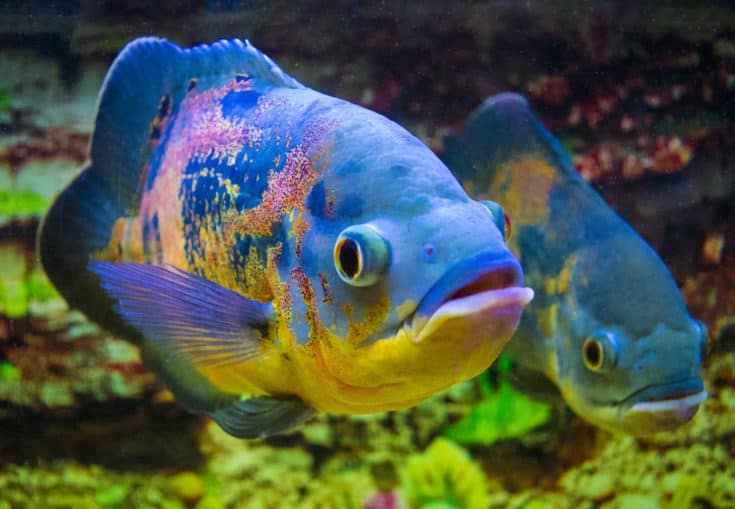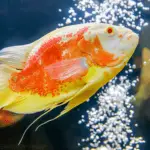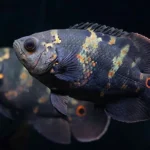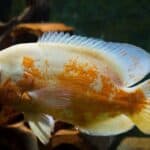Rainbow Oscar Fish, scientifically known as Astronotus ocellatus, belong to the cichlid family and are renowned for their vibrant colors and dynamic personalities. Hailing from various freshwater habitats in South America, they have become popular in the aquarium trade. Oscars are often referred to as velvet or marble cichlids due to their luxurious skin texture and varied, marbled coloration. As a widely recognized species within the aquarium community, they provide a unique combination of beauty and behavior that fascinates enthusiasts worldwide.
Understanding Oscars goes beyond appreciating their aesthetic appeal. These fish display a range of behaviors and temperaments that can be both charming and challenging for aquarists. Oscars require specific care to thrive in a home aquarium, including ample space, proper water conditions, and a well-rounded diet. Their social nature and intelligence also add to their appeal, allowing for a level of interaction that isn’t common in many fish species. For those considering breeding Oscars, it’s essential to be familiar with their specific reproductive needs and behaviors to ensure success.
Key Takeaways
- Oscars are a colorful and popular cichlid species known for their engaging personalities.
- Proper aquarium care, including space and water quality, is crucial for their wellbeing.
- Breeding Oscars demands understanding their unique reproductive behaviors.
Natural Habitat and Origin
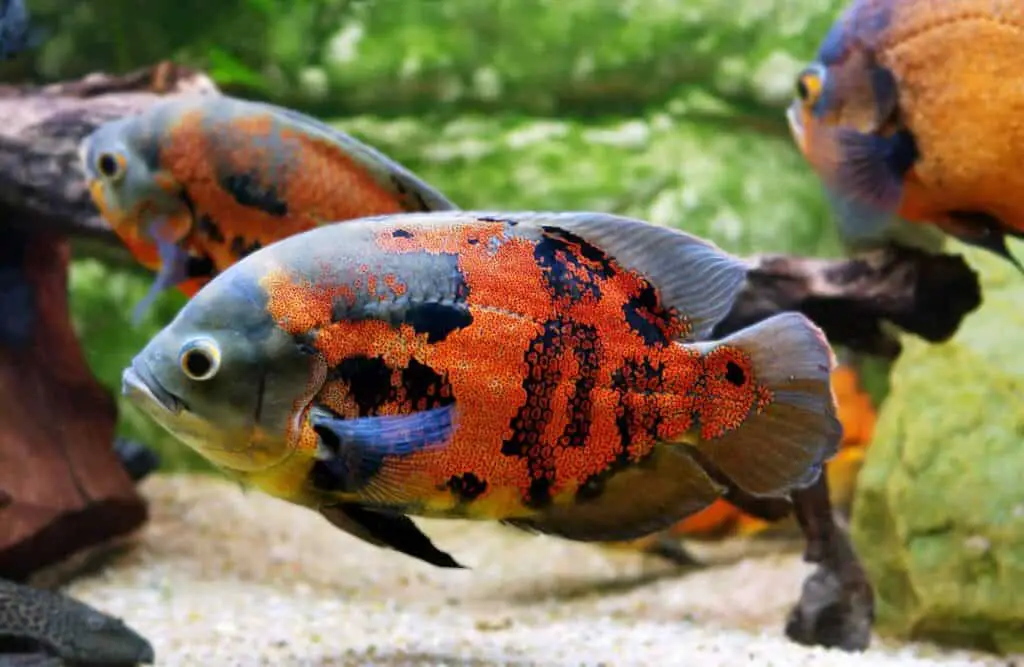
The Rainbow Oscar Fish is an intriguing species with a specific geographic and environmental niche in the wild. We will explore its geographical distribution and the environmental conditions that it thrives in.
Geographical Distribution
The Rainbow Oscar Fish, scientifically known as Astronotus ocellatus, is indigenous to South America. It predominantly inhabits the freshwater systems of the Amazon River Basin, which extends across several countries including Brazil, Peru, Colombia, Ecuador, and parts of French Guiana. Additionally, populations have been documented in the Orinoco River in Colombia and Venezuela.
Environmental Conditions
Rainbow Oscars are found in a variety of natural habitats within these regions. They tend to favor slow-moving waters, such as floodplain lakes, calm river margins, and areas with dense vegetation that offer shelter and hunting grounds. The water conditions in these habitats are typically warm and acidic, with a pH often ranging from 6 to 8, and temperatures between 23°C to 28°C (73°F to 82°F). Our understanding of these environmental elements is crucial because they play a significant role in Oscar Fish’s behavior and health.
Physical Characteristics

We begin by examining the distinctive features that characterize Rainbow Oscar Fish. These aquatic beauties exhibit a range of patterns and body structures that are both intriguing and key to their identification.
Color Variations and Markings
Rainbow Oscar Fish display a vibrant array of colors, often with intense hues and contrasting patterns. The base color typically ranges from olive to dark gray, but it’s the striking markings that set them apart. Tiger Oscars are renowned for their mixed palette of orange, red, and black, reminiscent of the big cat’s stripes, while other varieties may show splotches or marbling effects.
- Albino Variations: These Oscars trade the darker colors for a stark white or yellowish base with light pink or red markings.
- Eye Spot: An eye-catching feature often found on the dorsal fin and the caudal peduncle, this can be used by the fish to confuse predators or during mating displays.
Anatomy and Size
Rainbow Oscar Fish possess a robust and laterally compressed body, which aids in their agility within the water. Their anatomy reveals the following:
- Dorsal fin: Generally long and continuous, contributing to their streamlined shape.
- Gills: Well-developed to allow efficient breathing in various water conditions.
- Teeth: Oscars have small, set-back teeth suited for their omnivorous diet.
The average size of these Oscars is quite impressive:
- Length: Typically reaching 11-12 inches (28-31 cm) in captivity. Some individuals may grow larger under optimal conditions.
- Monomorphic nature: Both males and females share a similar size and appearance, making sex differentiation challenging based solely on physical traits.
Behavior and Temperament
In observing Rainbow Oscar Fish, we’ll find distinctive patterns in their behavior and temperament, particularly their social interaction and tendencies toward aggression and territorialism.
Social Interaction
Rainbow Oscar Fish possess a complex social structure. In a community tank, they often display curiosity towards other fish as well as their environment. They are not schooling fish, but they can recognize and interact with their owners, showing a level of intelligence that can be quite engaging. It’s crucial to provide sufficient hiding places, as Oscars do appreciate occasional solitude.
- Community Dynamics: Moderately tolerant of other species, but prefer other Oscars or similar sized fish
- Intelligence & Engagement: Exhibits recognition and interaction with owners, displaying higher intelligence among fish
Aggression and Territorialism
Our Rainbow Oscar Fish can become quite territorial, especially during breeding or when they feel threatened. They have a tendency to be aggressive, which is an essential factor to consider when placing them in a tank with other fish.
- Territorial Behavior: Often claim a certain area of the tank, sometimes aggressively
- Aggression Levels: Can vary from individual to individual, often exacerbated in cramped conditions
Tips for Reducing Aggression:
- Ensure ample space; Oscars grow large and need room to roam
- Introduce structured hiding places to offer refuge and a sense of territory
- Maintain a stable and consistent environment to reduce stress-related aggressive behavior
Aquarium Care
Maintaining a healthy environment for Rainbow Oscars requires attention to tank setup, diet, and vigilance against disease. Our aim is to create a stable, clean, and enriching habitat.
Tank Requirements
For Rainbow Oscars, the minimum tank size is 55 gallons, but we recommend at least 75 gallons to accommodate their large size and active nature. We ensure the water parameters—temperature between 74°F and 81°F (23–27°C), pH levels from 6.0 to 8.0—are consistently maintained. Rainbow Oscars thrive with ample space, so a larger tank is beneficial in preventing stress and territorial aggression.
To simulate a natural environment, we include substances such as sand or fine gravel and add decorations. Live plants can be used, but robust species are necessary as Oscars are known for rearranging their space. Driftwood also makes for excellent hiding spots.
Filtration is critical in keeping the water clean and oxygenated. We use a powerful filter that can turn over the water volume several times an hour, as Oscars produce a significant amount of waste.
Feeding and Diet
Rainbow Oscars are omnivores; their diet in the aquarium should include both meaty foods and plant matter to keep them healthy.
| Protein Sources | Plant Sources |
|---|---|
| Bloodworms (live or frozen) | Spirulina or algae wafers |
| Krill | Cooked peas |
| Shrimp | Zucchini slices |
| Pellets with high protein content |
Feeding should be done once or twice a day, providing food they can consume within two minutes to prevent overfeeding.
Health and Diseases
Our Oscars are susceptible to a variety of common diseases, such as ich or white spot disease, characterized by white cysts on the skin and gills. Treatment typically includes increasing the tank temperature to speed up the parasite’s life cycle and administering medication. Another ailment is hole in the head disease, which manifests as lesions or pits on the head and can be treated with improved water quality and diet. Fin rot arises from poor water conditions which can be managed by regular water changes and sometimes antibiotics.
We’re vigilant in watching for signs of illness, such as unusual swimming patterns, loss of appetite, or visible wounds. Early detection is vital, as treatment is more successful when initiated promptly. Improving tank conditions and consulting a veterinarian for severe cases is our protocol for managing diseases.
Breeding and Reproduction
In managing the breeding and reproduction of Rainbow Oscar Fish, it’s important for us to understand the nuances of their mating behaviors and the specific care required for their fry. This ensures the health and longevity of these captivating freshwater fish within our aquariums.
Mating Behavior
Rainbow Oscars exhibit distinct mating behaviors that we can observe. Initially, these fish partake in a courtship dance, involving chasing and gentle nipping. It’s our responsibility to provide a spacious aquarium since Oscars require ample room to perform these rituals. We often see Oscars preparing a flat surface for spawning by cleaning it thoroughly. Once the female lays the eggs, both parents will guard their brood fiercely.
- Courtship: Includes chasing and nipping
- Spawning Surface Preparation: Cleaning of flat surfaces
- Parental Guarding: Both male and female Oscar fish protect the eggs
Raising Fry
After the eggs hatch, we shift our focus to raising the fry with utmost care. The parents typically continue to guard the fry until they are capable of fending for themselves. We ensure the survival of the fry by maintaining ideal water conditions and providing specialized foods. In the initial stages, the fry feed on their egg sacs, but soon after, they require high-protein foods such as baby brine shrimp.
Feeding the Fry:
- Stage 1: Egg sac nourishment
- Stage 2: Introduction of baby brine shrimp and other high-protein fry foods
Proper water quality is crucial for the fry’s development. We regularly check parameters such as temperature, pH, and ammonia levels. Any fluctuations can adversely affect the fry’s health, which is why we perform frequent water changes and utilize a reliable filtration system. Our careful attention during these early stages paves the way for a healthy lifespan for our aquarium pets.
Frequently Asked Questions
In this section, we aim to address some of the most common inquiries regarding the care and maintenance of Rainbow Oscar Fish.
What are the ideal tank conditions for Oscar fish?
For optimal health, Oscar fish require a water temperature between 74°F and 81°F with a pH level ranging from 6.5 to 7.5. It’s important to maintain high water quality through regular filtration and water changes, as Oscars are sensitive to poor water conditions.
How can you properly care for an Oscar fish?
Proper care for an Oscar fish includes providing them with a varied diet consisting mostly of high-quality pellets, supplemented with live or frozen food such as worms and insects. Regular tank cleaning and monitoring water parameters are crucial for their well-being.
What are suitable tank mates for Oscar fish?
Oscar fish are best paired with similarly sized and temperament species to avoid aggression. Consider larger, peaceful fish such as certain cichlids or catfish. It’s important to avoid smaller fish that Oscars might view as prey.
How long do Oscar fish typically live?
With proper care, Oscar fish can live for 10 to 15 years. Lifespan can be maximized by ensuring an appropriate diet, suitable tank conditions, and regular health check-ups.
What is the proper tank size for housing two Oscar fish?
For two Oscar fish, a minimum tank size of 75 gallons is recommended. Oscars grow large and produce a significant amount of waste, so ample space is important to prevent stress and health issues.
What are the different color variations of Oscar fish?
Oscar fish are known for their varied color patterns, including red, orange, and yellow. The Rainbow Oscar specifically exhibits a mix of vibrant colors. Other variations include Tiger Oscars, Albino Oscars, and Lemon Oscars, each with distinctive markings and hues.
